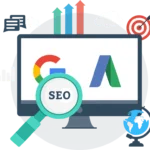
The SEO and Google Ads debate comes up often. One promises long-term organic visibility. The other delivers fast, paid traffic. But treating them as separate strategies limits your potential.
Google Ads and SEO each serve a purpose. SEO builds authority and organic rankings over time. Google Ads gives you instant visibility when it counts. A combined strategy brings both together to cover the entire customer journey from discovery to conversion.
As a trusted PPC agency that specialises in performance-driven campaigns, we know how powerful search can be when both sides work together. In this guide, we’re breaking down how SEO and PPC align, when to use each, and how to create a strategy that delivers consistent results.
Before you decide how to use SEO and Google Ads together, it’s important to understand how they work individually.
SEO (Search Engine Optimisation) focuses on earning visibility through organic rankings. It improves your site’s structure, relevance, and authority so that you show up in search results without paying for every click. It takes time to gain traction, but the traffic is sustainable.
PPC (Pay-Per-Click), typically through Google Ads, delivers fast, paid placement in search results. You bid on keywords, set a budget, and your ad appears above the organic listings. It drives immediate traffic, but only while your campaign is running.
Here’s a quick comparison:
| Element | SEO | PPC (Google Ads) |
| Cost Per Click | No | Yes |
| Time to See Results | Long-term | Immediate |
| Traffic Source | Organic | Paid |
| Trust Factor | High | Lower (marked as ad) |
| Sustainability | Ongoing with content effort | Stops when you pause spend |
Understanding the SEO vs PPC difference helps you see where each strategy fits, and why the most effective campaigns often rely on both.
Both SEO and Google Ads have a place in a high-performing strategy. But they each come with trade-offs. Knowing the strengths and limitations helps you choose the right mix.
The right strategy often depends on your goals, budget, and timeline. If you’re launching a new service, PPC can give you a fast start. If you’re building long-term growth, SEO gives you staying power.
SEO and Google Ads are not competing strategies. They solve different problems and support different parts of the funnel. When used together, they give you more control, more data, and better results.
Showing up in both the paid and organic sections of the search results increases visibility and authority. Users are more likely to click when they see your brand in multiple places.
PPC gives you immediate feedback on which keywords convert. You can use this data to prioritise SEO efforts, fine-tune content, and reduce guesswork.
Google Ads targets high-intent keywords at the bottom of the funnel. SEO supports top and mid-funnel searches where users are still comparing options. Together, they guide users from awareness to action.
When users see your brand in both ad placements and organic results, it builds familiarity. This improves click-through rates and increases trust, even if the user doesn’t convert right away.
If SEO rankings dip, Google Ads can help maintain traffic. If ad costs rise, SEO offers a stable source of leads. A combined strategy reduces risk and keeps results consistent.
A well-structured plan brings the strengths of each channel into one cohesive strategy. It’s not about choosing SEO vs PPC. It’s about knowing how they work together.
SEO and Google Ads need shared goals. Use Google Ads for high-intent keywords that convert fast. Use SEO for broader terms that grow traffic over time. Keep your messaging aligned so users get a consistent experience across both.
Ad data gives you quick feedback. Use it to shape your SEO content and keyword targets. SEO can also uncover long-tail terms to test in paid campaigns. Sharing insights across both channels makes every move more informed.
Send paid traffic to pages built to convert. Use organic content to educate and build trust. Budget should match intent. Use PPC for fast results and SEO for long-term growth. Track performance in one place so nothing gets missed.
Running SEO and Google Ads side by side only works if the strategy is connected. One of the biggest mistakes is treating them as separate campaigns. This leads to mixed messaging, duplicated effort, and wasted budget.
Another issue is focusing too much on traffic and not enough on intent. Just because a keyword performs well in SEO doesn’t mean it’s right for paid. The same goes in reverse. Every keyword needs to be mapped to its purpose and aligned with the right content.
Finally, skipping tracking holds everything back. If you’re not measuring results across both channels, you won’t know what’s working. Set clear goals, use consistent metrics, and review performance regularly. The more connected your data, the more effective your strategy.
It’s not about choosing between SEO and Google Ads. It’s about using both to reach more of the right people and drive better results. SEO builds long-term visibility. Google Ads delivers immediate traffic. Together, they give you the coverage and control that a single-channel strategy can’t.
If your goal is sustainable growth, a combined strategy makes sense. It’s measurable, efficient, and built for how people actually search.
To get it right, it helps to work with a digital marketing team that understands both SEO and paid search. If you want to see how that looks in practice, take a look at how DCB Digital connects SEO and Google Ads to build strategies that perform.